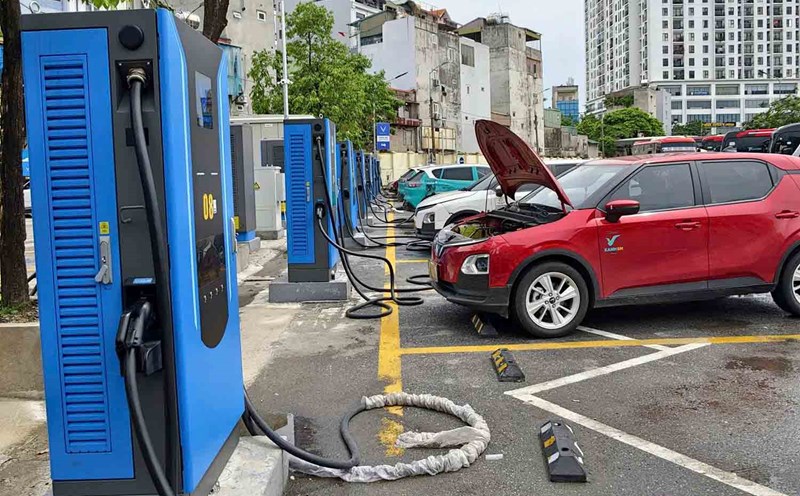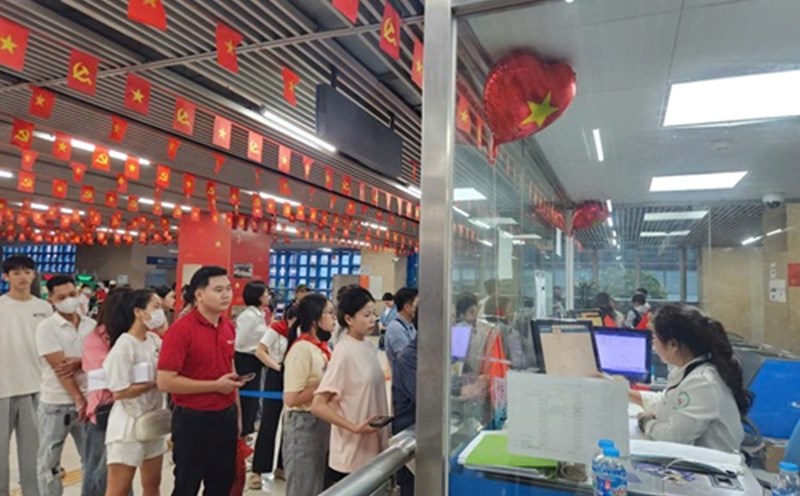In Vietnam, especially in Hanoi, the process of greening public and private transportation has been strongly promoted. However, to ensure this process goes smoothly, developing charging station infrastructure is an inevitable requirement.
Charging station network is expanding
In the blue picture of Hanoi's transportation, charging stations have appeared more often and created initial peace of mind for users. According to the Hanoi Department of Construction, the whole city has about 1,000 charging stations installed, including both private and public stations. Among them are 57 large-capacity public stations from 120 - 150 kW, 259 AC/DC mixed stations and 684 private stations. In addition to installation points in residential areas and commercial centers, large bus stations have also quickly taken action, opening a more convenient network of charging stations for electric vehicles.
At Giap Bat bus station, the Southeast area has been allocated more than 500m2 to build a separate charging station for electric cars. This station has 20 pillars, each pillar has two trip ends, serving 40 vehicles at the same time. With a capacity of 120kW, each vehicle only takes about 30-40 minutes to fully charge. At Gia Lam bus station, more than 30 charging sockets have also been put into operation, creating favorable conditions for people.
Electric vehicle users also highly appreciate this change. Mr. Nguyen Ba Minh, an electric taxi driver in Dong Ngac, Hanoi, said: Before switching to electric vehicles, I was worried about finding a charging place. However, when he switched to driving an electric car, he found this worry unnecessary. Now, in any area of Hanoi, we can easily find a charging station. The charging is convenient, so taxi drivers are completely assured".
Another resident, Ms. Le Thi Huyen in Cau Giay, Hanoi, also shared: My family has been buying electric cars since the beginning of the year. At first, I was wondering because there were not many charging stations, but now in the neighborhood, shopping malls or bus stations, there are stations. I find this development makes me more confident when choosing green vehicles".
Not only serving personal vehicles, Hanoi is implementing a series of major projects to convert the public transport system to using clean energy. In particular, the plan to develop electric buses, renovate waiting rooms and deploy interconnected electronic tickets is being implemented synchronously. This shows that charging station infrastructure is not only for individuals, but also a foundation for green public transport, contributing to reducing congestion and pollution.
Still need more motivation
The charging station network has been formed and expanded, but according to experts, to meet the green transformation speed, more strong momentum is still needed. This is a new field, requiring support from policies, planning to incentive mechanisms.
Dr. Khuong Kim Tao - former Deputy Chief of Office of the Traffic Safety Committee - emphasized: "In the immediate future, it is necessary to cordon off the emission zone, in which only electric vehicles are allowed or meet high emission standards. This is a way to force the market to adapt quickly to green vehicles".
Another barrier comes from technical regulations and standards. Currently, the Ministry of Science and Technology has only issued a number of standards related to sockets and charging station equipment, but there is no detailed guidance on planning, power supply and safety. This makes it difficult for businesses to invest on a large scale.
Along with issuing regulations for charging stations, the authorities need to add specific solutions to promote charging stations. Accordingly, some direct solutions that need to be considered are support for land allocation, land lease, land use conversion; policies on support for tax and fee fees, electricity prices, etc.
Mr. Thai Ho Phuong - Director of the Hanoi City Traffic Management and Operation Center - said that Hanoi is implementing many large-scale projects, including a plan to develop 598.6km of urban railway by 2045, along with converting all buses to electricity and green energy. "Synchronous solutions, along with the active participation of businesses, will certainly help Hanoi's transportation become greener and more sustainable. But clearly, to make progress quickly, it is necessary to have more mechanisms to encourage investment in charging stations".











